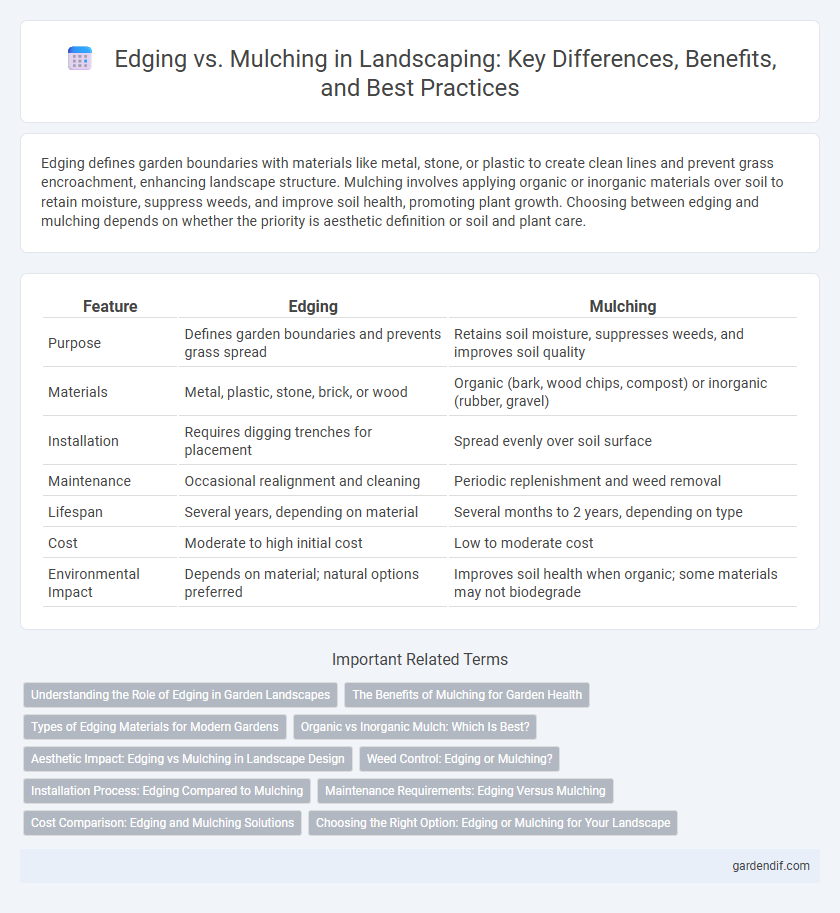
Edging vs Mulching Illustration
Edging defines garden boundaries with materials like metal, stone, or plastic to create clean lines and prevent grass encroachment, enhancing landscape structure. Mulching involves applying organic or inorganic materials over soil to retain moisture, suppress weeds, and improve soil health, promoting plant growth. Choosing between edging and mulching depends on whether the priority is aesthetic definition or soil and plant care.
Table of Comparison
| Feature | Edging | Mulching |
|---|---|---|
| Purpose | Defines garden boundaries and prevents grass spread | Retains soil moisture, suppresses weeds, and improves soil quality |
| Materials | Metal, plastic, stone, brick, or wood | Organic (bark, wood chips, compost) or inorganic (rubber, gravel) |
| Installation | Requires digging trenches for placement | Spread evenly over soil surface |
| Maintenance | Occasional realignment and cleaning | Periodic replenishment and weed removal |
| Lifespan | Several years, depending on material | Several months to 2 years, depending on type |
| Cost | Moderate to high initial cost | Low to moderate cost |
| Environmental Impact | Depends on material; natural options preferred | Improves soil health when organic; some materials may not biodegrade |
Understanding the Role of Edging in Garden Landscapes
Edging defines clear boundaries between garden beds and lawn areas, enhancing visual appeal and preventing grass encroachment into planting zones. It contributes to soil retention and moisture control by keeping mulch and soil in place, promoting healthier plant growth. Selecting durable materials like metal, stone, or plastic ensures long-lasting garden structure and reduced maintenance.
The Benefits of Mulching for Garden Health
Mulching improves garden health by retaining soil moisture, regulating temperature, and reducing weed growth, which promotes stronger plant development. Organic mulches decompose over time, enriching the soil with vital nutrients and enhancing microbial activity essential for nutrient absorption. This natural process strengthens plant resilience against pests and environmental stress, making mulching an effective strategy for sustainable garden maintenance.
Types of Edging Materials for Modern Gardens
Modern gardens utilize diverse edging materials such as natural stone, metal, brick, and plastic to create clean, defined borders that enhance aesthetic appeal and functionality. Natural stone offers durability and a rustic look, while metal edging provides a sleek, contemporary finish ideal for precise garden shapes. Brick and plastic materials are versatile and cost-effective options that accommodate various landscape designs and plant types.
Organic vs Inorganic Mulch: Which Is Best?
Organic mulch, such as wood chips and shredded leaves, enriches soil fertility by decomposing and adding vital nutrients, promoting healthy plant growth and moisture retention. Inorganic mulch options like rubber or stone provide long-lasting weed suppression and durability but do not improve soil quality. Choosing between organic and inorganic mulch depends on landscape goals: organic enhances soil health while inorganic offers low maintenance and longevity.
Aesthetic Impact: Edging vs Mulching in Landscape Design
Edging creates a clean, defined boundary that enhances the visual structure of garden beds, while mulching provides a uniform surface that promotes a natural, polished look. Edging materials such as metal, stone, or plastic add texture and contrast, emphasizing landscape shapes and pathways. Mulch varieties like wood chips or bark soften the garden's appearance, helping to blend plants seamlessly with the surrounding soil and improving overall garden aesthetics.
Weed Control: Edging or Mulching?
Mulching provides superior weed control by blocking sunlight, which inhibits weed seed germination and suppresses existing weeds, while edging primarily serves to define garden beds and prevent grass encroachment but doesn't reduce weed growth within the beds. Organic mulches like wood chips or bark improve soil moisture retention and nutrient levels, creating an environment less favorable for weeds. Combining edging with mulching optimizes landscape weed management by physically restricting weed intrusion and chemically suppressing weed development.
Installation Process: Edging Compared to Mulching
Edging installation involves placing physical barriers such as metal, plastic, or stone along garden beds to define boundaries and prevent grass intrusion, requiring precise trenching and secure anchoring. Mulching requires spreading organic or inorganic materials like wood chips or gravel evenly over the soil surface, focusing on soil moisture retention and weed suppression with less structural setup. Edging demands more labor-intensive preparation and tools, while mulching offers a quicker, less technical application process.
Maintenance Requirements: Edging Versus Mulching
Edging requires periodic trimming, realignment, and replacement of materials such as metal, stone, or plastic to maintain a clean boundary, while mulching involves regular replenishment to preserve soil moisture, suppress weeds, and enhance nutrient levels. Mulch naturally decomposes over time, demanding more frequent application, whereas edging provides a more durable yet labor-intensive barrier. Both methods reduce lawn maintenance but differ in upkeep frequency and material durability, influencing long-term landscape management costs.
Cost Comparison: Edging and Mulching Solutions
Edging materials typically cost between $1 and $5 per linear foot, with options like plastic or metal offering durable boundaries but higher initial investment. Mulching ranges from $20 to $60 per cubic yard depending on type, such as organic bark or rubber, providing affordable soil moisture retention and weed suppression. Combining edging and mulching can optimize landscape aesthetics and maintenance budgets by balancing upfront costs with long-term benefits.
Choosing the Right Option: Edging or Mulching for Your Landscape
Choosing between edging and mulching for your landscape depends on the desired benefits and maintenance levels; edging creates defined borders that prevent grass intrusion and provide a clean look, while mulching improves soil moisture retention, suppresses weed growth, and enriches soil nutrients. For gardens requiring clear separation between lawn and planting beds, durable materials like metal or plastic edging are ideal, whereas organic or rubber mulch suits areas needing enhanced soil health and temperature regulation. Combining both techniques can maximize landscape aesthetics and plant health by maintaining sharp lines alongside nutrient-rich soil conditions.
Edging vs Mulching Infographic

 gardendif.com
gardendif.com